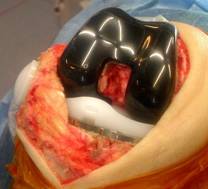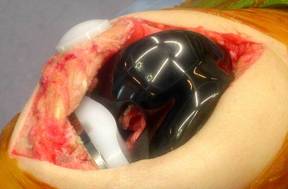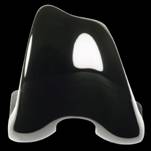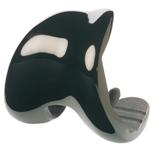The phenomenon of ‘wear’ is of great concern to orthopaedic surgeons carrying out knee and hip replacements. Whenever two surfaces move or rub relative to one another there is always a problem with the production of wear particles especially when one of the bearing surfaces is softer like for example, polyethylene, in the knee.
Most current femoral components in total knee replacements are made of cobalt chrome. Excellent results are currently being achieved with this material. However these implants can roughen over time when placed in the body. In the knee when the femoral component rubs over the plastic (polyethylene) insert, the plastic surface can start to wear out or break up. The rougher the femoral surface the worse the amount of wear. These plastic wear particles or ‘debris’ can be responsible for the failure of the whole knee replacement not only due to the thinning of the plastic insert itself but also due to the body’s reaction to the microscopic particles which can cause loosening and thinning of bone at the implant interface.
Mr Rees is one of a few surgeons in the UK currently using a revolutionary new material called oxidised zirconium also known as oxinium. Oxinium is produced as a result of a chemical process that allows oxygen to absorb into zirconium metal thereby changing only its surface from metal to ceramic. This new material may be considered for young patients (under 65 years of age) undergoing total knee replacement.


Photos of an oxinium knee replacement having just been implanted
Compared to cobalt chrome, oxinium has
- Superior hardness
- Superior smoothness
- Increased resistance to scratching or abrasions
- No detectable nickel content (the leading cause of adverse reactions in patients with a metal allergy)
Oxinium has been designed to be long lasting and as it offers reduced friction within the knee, it can significantly increase the longevity of the prosthesis and decrease wear rates. Although oxinium is a relatively new material to be used in knee replacements, orthopaedic surgeons both in the US and Europe have been using oxinium joint replacements for more than eight years, in over 20,000 patients, with great success. The oxinium material has also been rigorously tested to meet regulatory guidelines and has passed strict quality control measures prior to its clinical introduction.


Photographs of oxinium femoral prosthesis (Smith & Nephew Genesis II)
Further details about this new material can easily be discussed at the time of consultation but more information can be obtained from the oxinium web site.
